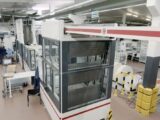Berry Global Unveils the United States’ First Comprehensive, Commercial-Scale Clean Room for Nine-Layer Blown Film Manufacturing
August 8, 2021Berry Global Group announced its new commercial-scale clean room for blown film, supporting its growing healthcare business in rigorous healthcare and pharmaceutical applications.
The ISO 7 class clean room can produce nine-layer blown films. The new installation fully encloses commercial-scale production of Berry’s proprietary nine-layer blown film from extrusion to packaging, a first in the United States. The addition further enhances Berry’s ability to supply more sensitive applications such as sterile intravenous solution bags, pharmaceutical packaging, medical equipment manufacturing, and microchip packaging.
Significant Customer Benefits
Installed in Berry’s existing Dalton, Georgia, facility, the clean room provides a controlled environment, complete with FDA-approved lubricants and contact surfaces, and a 100 percent inspection system for real-time defect detection for quality assurance. Berry’s new clean room installation reduces foreign particulates by up to 99.9 percent compared to a conventional production environment. Customers will benefit from Berry’s globally recognized expertise in material science, combining multiple layers for optimal product performance and reliability for the most delicate applications. In addition, the newly installed blown film line can be monitored remotely, upholding the integrity of the clean room.
“The addition of the United States’ first commercial-scale, fully enclosed clean room manufacturing provides customers with optimal product safety for the specific needs of healthcare and pharmaceutical applications,” said Curt Begle, President of Berry’s Health, Hygiene, and Specialties Division. “This enhanced capability, paired with our unmatched supply reliability, means customers can benefit from a dependable supply of films for the most sensitive of applications, allowing customers to avoid recalls and potential waste due to package contaminants.”
